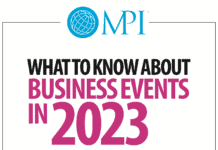
What are today’s top event trends? Prevue asked Brian Kellerman of experiential marketing and event management company GoGather what’s on his radar screen.
The granddaddy of event trends, the one that so many others have emerged to support, is the drive toward using meetings and events to support the organizer’s business objectives. Brian Kellerman is such a believer in this event trend that it is the driving force behind everything an experiential marketing and event management company he is CEO and Partner of — GoGather — does. “It’s not enough to know how to order the food and beverage and linens,” he says. “We need to always be thinking of how those things translate into meaningful experiences that will accomplish the strategic goals of the company or association.”
Prevue recently caught up with Kellerman to learn more about the event trends he sees that spin out of that core concept.
Prevue: How to use AI to better accomplish those goals is a main event trend we’re hearing about lately. How do you see that event trend playing out?
Kellerman: The first thing to remember is that it’s a tool, not an answer in itself. At GoGather, we’ve developed a GoGather version of ChatGPT that has been trained on some of our standard contractual language and our SOPs. When our team members have a question or are facing a challenge, they can get answers from our version of ChatGPT that includes some of our parameters around strategic meeting management, for example. We use it to help analyze attendee feedback pre-event on the registration form, when we ask them what they want to experience at the event, the major challenges they’re facing, etc. We also use it to analyze post-event survey data.
While I use it every day, AI doesn’t do my work for me. It doesn’t write my emails or make proposals for me, but it does help me outline and set priorities.
Prevue: That sounds like a good resource to have. Do your clients have similar customized resources and technologies, AI-powered or otherwise, that they can tap into?
Kellerman: Some of the organizations we work with have internal resources and data that event teams can leverage, which is important because sometimes internal planners can feel a bit isolated from their organization’s resources and technologies. It’s important for internal planners, as well as third parties, to probe exactly what technologies may be available, and find ways to tap into them so you don’t have to reinvent the wheel.
Prevue: What are some other event trends you’re noticing these days?
Kellerman: The way individuals are using technology, both at the workplace and at home, have changed the way people are consuming information, and it’s important for event planners to accommodate to those changes — including a shortened attention span. People aren’t willing to sit and listen to speaker after speaker at a four-hour general session anymore. Now we may want to limit it to an hour, maybe even 45 minutes, then bring people into other environments where they can further explore the ideas they learned.
Taking people into non-traditional areas for breakouts also is on the rise. We’ll still use the traditional breakout spaces, but let’s also look at where we can utilize spaces throughout the venue. Is there an outdoor area a small group can gather in? Can they go to a restaurant, or a hospitality suite on a different floor? Give people an opportunity to move around.
People also are going to be on their cellphones. They just are. Rather than try to fight it, recognize that you are competing with their cellphones for attention, so it’s important to design accordingly to accommodate for that.
It’s important to recognize and lean into those behaviors.
Prevue: One way to wrap cellphones into the overall experience is gamification — is that still a good way to engage attendees or is it getting a bit passe?
Kellerman: We work a lot with organizations that are very sales-centric, and salespeople tend to be naturally competitive and yes, they definitely enjoy gamification at events. But even for organizations that aren’t as sales-centric, we continue to see gamification work really, really well. But it has to be done right. For example, it works best when you have a professional emcee or game show host driving the games. You want people to actually feel connected through the game without creating a situation where people lose interest in playing, for example where there’s a leaderboard keeping score. People who aren’t close to winning may give up.
You don’t have to think of gamification as just being points-based. Include other incentives for participating to give everyone a chance to score.
Prevue: What other audience engagement strategies seem to be working well these days?
Kellerman: Lining people up in rows classroom style doesn’t seem to work anymore. Provide a variety of different seating arrangements, including some standing spaces, some crescent rounds, can help keep them more engaged. We also do more with panels — we recommend those over single speakers. Town hall style sessions also are more engaging. Even something like a Catchbox, a soft-sided box with a microphone inside that people can toss around the room during a Q&A, can increase engagement.
Mosaic social media walls, while not new, create a lot of fun engagement as people create mosaics on site made of the photos taken or tagged to the event. Again, that gives people an opportunity to use the cellphone they’re on anyway to engage with the event.
For more of Brian Kellerman’s perspectives, check out the Gather Gurus Podcast, which he co-hosts with Katie Moser.
You May Also Be Interested In…
Cost Is Increasingly a Key Site Selection Factor
C-Suite Pegs In-Person Meetings as Essential










